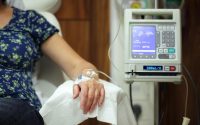How Susannah Cahalan’s ‘Brain on Fire’ memoir has saved lives
In 2009, Susannah Cahalan — then a Sunday reporter at The Post — wrote about her “mysterious lost month of madness.” After a spate of numbness, sleeplessness, wild mood swings, psychosis and seizures, she spent a month in the hospital, misdiagnosed with serious mental illness, before doctors discovered she was the 217th person in the world to be diagnosed with a newly discovered brain disease: autoimmune encephalitis. Her story, including a remarkable recovery, turned into the 2012 best-selling memoir “Brain on Fire” and later a movie of the same name. It has also helped save many lives. Here, Cahalan shares an excerpted update from the 10th-anniversary edition of the book, out later this month.
I stared at the unwrapped gift, struggling to recognize what I was holding. It looked like lumpy mashed potatoes.
“It’s a candle,” my brother, James, said. A candle? But this had no botanical scent or wick, no obvious way to hold a flame. I examined the yellow, fillet-sized mass in my hands until the object came into focus: it was an anatomically correct brain with wrinkly grooves and two identical hemispheres.

James bought it during a trip to Lisbon at one of the oldest candle shops in the world. He asked the two women who worked there about the shop’s strange organ candles—a femur bone, a lung, even a kidney. James couldn’t understand it all, but he came away with instructions: They were meant to represent the overcoming of a trial. The key was to burn them when the person was ready to move on.
It took him a beat to think of someone who would beneft from such a candle. “Do you have a brain?” he asked. “Yes, yes! We only have one left.”
Months later in my apartment in Brooklyn, holding that brain in my hands, I was touched by the sentiment but also, despite myself, wounded by it.

I had done everything possible to prove my mastery over that broken brain: I had written a book, spoken endlessly in lecture halls and medical school auditoriums, and sat through the surreal experience of watching my book adapted into a movie. What would it take to prove that I had overcome? I put the brain candle on my bookcase and made a mental note to burn it as soon as I got the chance.
That was two years ago. The brain sat in my living room until I moved to a new house, where it sits on a writing desk in my cluttered office. Looking at it now, I think of the Epicurus quote: “Against other things it is possible to obtain security, but when it comes to death we human beings all live in an unwalled city.”
I have not been brave enough to throw my brain into the fire.

I’m writing this 13 years after my diagnosis with autoimmune encephalitis, a decade after the publication of my book “Brain on Fire,” and five years after my husband, Stephen, and I exchanged our vows (which, to Stephen’s absolute befuddlement, is the answer to the second-most Googled question about the book). I’m now on the border of middle age. I have three-year-old twins who leave me delirious with joy, exasperation and sleep deprivation. And I cling to the hope that life will never be as chaotic as it was when I wrote this book.
There have been changes since I wrote this book. Positive ones.
I don’t talk in my sleep anymore and I’ve stopped smacking my lips when I eat, a symptom that followed me for years. I still struggle to find the right words, but I try not to attribute these lapses to my brain illness, and instead to my inherent shortcomings. I still have a bald spot from the brain biopsy, and sometimes I reach up to check and make sure it’s not visible. According to a blood test done years ago, my body still houses the brain-targeting autoantibodies that made me sick. My physician, Dr. Souhel Najjar, isn’t alarmed, mostly intrigued.

I am off medication and have not had a relapse, but I’ve had a few run-ins with what Virginia Woolf called “the undiscovered countries” of illness — a diagnosis of melanoma, a stomach- churning (and rare) allergy to chia seeds, and a terrifying bout with vertigo that rattled my confidence for months.
I still fear the words “interesting patient.”
In the hospital after my twins were born, I surprised the staff by showing signs of preeclampsia after birth. The pain in my abdomen was so intense that it felt like being stabbed by an invisible knife. But the staff dismissed my intense suffering. One doctor asked me with clear condescension, “Is this your first time having surgery?” (I nearly spat back: I’ve had several surgeries, including a brain biopsy.) A nurse thought she was helping to rally me to the bathroom when she said, “Do it for your babies!”

It took two days of projectile-vomiting bile before another nurse was able to convince the attending physician to do an X-ray on my stomach. When she did, there was evidence of ileus, or a blockage in my intestines.
“I haven’t seen one of these in decades!” said one of the doctors.
Please, don’t ever let me be interesting again.

Luckily, in the past 10 years, I’ve lost my interesting status and have become a “classic case.” Had I presented with the same symptoms last year, I’m certain that my diagnosis would have come far faster than it did in 2009. Recognition is vastly improved. Diagnosis is happening at the earliest stages — in emergency room settings and even in the offices of family doctors. To give you some perspective on the change at the research level: If I had been capable of searching on PubMed using the terms “autoimmune encephalitis” when I was sick, I would have found 84 papers ever written; now there are more than 2,000 papers on this subject. Textbooks dedicate chapters to it. Medical students learn it before they even start treating patients. All of this advancement is key: a faster diagnosis often equates to a more robust recovery.
The past decade has also seen a dramatic rise in the community surrounding autoimmune encephalitis. Nonprofts, family organizations, and Facebook groups dedicated to helping spread the word and connecting people with care — which didn’t exist when I was sick — are now a Google search away. Two of my personal favorites are the Autoimmune Encephalitis Alliance and the Encephalitis Society. I recommend reaching out to both if you suspect you or a loved one has autoimmune encephalitis.

There are also far more concrete numbers about the prevalence: There’s about a one in a million shot at getting anti-NMDA-receptor autoimmune encephalitis. (The incidence rate jumps to 1 in 100,000 when you account for the 20-plus newly discovered kinds of autoimmune encephalitis.) This sounds rare — you’re more likely to be struck by lightning — but there’s a small city full of the diagnosed who didn’t exist when I was one of only 217 people. Now there are tens of thousands, if not more of us, all over the world.
The portrait of a typical patient has remained consistent — a woman in her early twenties (though recent studies are showing that older people are likely being under-diagnosed). The disease is still more prevalent in women, which is true of autoimmune diseases in general, highlighting questions about the complexity of female immune systems, misdiagnosis of chronic versus acute conditions and the marginalization of women’s pain.

There is still no FDA-approved drug for autoimmune encephalitis, which means that all treatment is still “off label,” a serious issue that several doctors are trying to remedy in clinical trials.
Still, about 75 % of us will recover to “functional independence,” with what is perceived as a “good recovery.” But what does “good” mean, anyway? These are some of the questions I’ve received from people during their recoveries: Will I ever be able to concentrate again? When will I be well enough to return to school? Will I ever not be tired? Will my girlfriend still love me? Will I be able to have children? Will I ever be ‘me’ again?
Though doctors are far more comprehensive in follow-up than they were when I was diagnosed (no one ever asked me how I was doing emotionally, or suggested that I see a therapist), the goal of “functional independence” still seems shallow and incomplete.

“Outcomes are ‘good,’ but not good enough,” Mayo Clinic neurologist Dr. Gregg Day told me. He wants to help his patients return to what they consider to be good outcomes, not just what objective tests of mobility or cognitive functioning show. He had this breakthrough when meeting with a patient who broke down after he asked, “How are you?” Through her tears she confided that earlier that day she received a concerned call from her son’s school about his lunch, which consisted of two slices of bread with nothing inside. She felt humiliated by this lapse because it revealed how far she still was from a true return to herself pre-illness. This only came up because Dr. Day had asked that simple but illuminating question: How are you?
A few months ago, I received a desperate email from a family whose adult daughter disappeared after a psychotic break that they believed might have been immune related. They were hamstrung as she refused care and left her home to live on the streets.

They finally convinced her to go to the hospital, where emergency room doctors treated her for autoimmune encephalitis, but because of the length of time she went untreated, it is unclear if she will ever achieve a so-called good recovery.
I am deluged with the outpouring of emails from others who are dealing with dismissive doctors, or greedy insurance companies refusing coverage, or symptoms that are so diffuse that it takes months, if not years, to receive an accurate diagnosis. The terrible reality is that our medical care system continues to fail vast numbers of people who need help. These are the stories that I can’t get out of my head.
I take some comfort in the fact that my book has helped many people. I can say with certainty that my story has even saved lives. (Writing that sentence will never stop astounding me.) It’s impossible to know how wide my story’s reach has been, but I can say that hundreds of people have contacted me with stories of how my book helped them find a diagnosis. A doctor friend told me that her hospital tests anyone coming in with signs of a first psychiatric break for “brain on fire.” At least a dozen nurses have told me that they have made an autoimmune encephalitis diagnosis after reading my book.

Medical students have shared personal stories of pursuing careers in neurology or
psychiatry after reading my story. Parents take my book to doctor appointments and physicians recommend that people in the midst of recovery read it for solace and inspiration. One mother told me that it helped her better understand the experience of her nonverbal son. A high school student told me that it gave her the support necessary to seek out help with her suicidal thoughts. I’ve received emails from all over the world—from India and Germany, Syria and Brazil. One of the highlights of my life was sitting in a room full of Japanese families after the movie premiere there, each telling me the ways that the book helped them find a diagnosis or a route along the long, unsettled road of recovery.
I don’t think I can express what this has meant to me. I’m proud to say that my story doesn’t belong to me anymore. It belongs to you.
But if that brain candle is any indication, I’m still having a hard time letting go of the past. I called my brother to talk about the candle and, as we spoke, James realized then that he had gotten it a bit wrong in the initial retelling. These organ candles were not meant as a symbol of moving on, something to destroy so that you could blaze forward and leave the past behind. These were objects of acknowledgment.
The candle was meant to be laid out as an offering, as an acknowledgment of grace, as an act of awe and love. They weren’t lit to erase the pain, but to honor it.
This sounds like something I could do.
Maybe tonight I will finally do it, start a big fire and take stock of all this living I got to do in the past decade.
And when I do, I will think, “This brain on fire is for you.”


